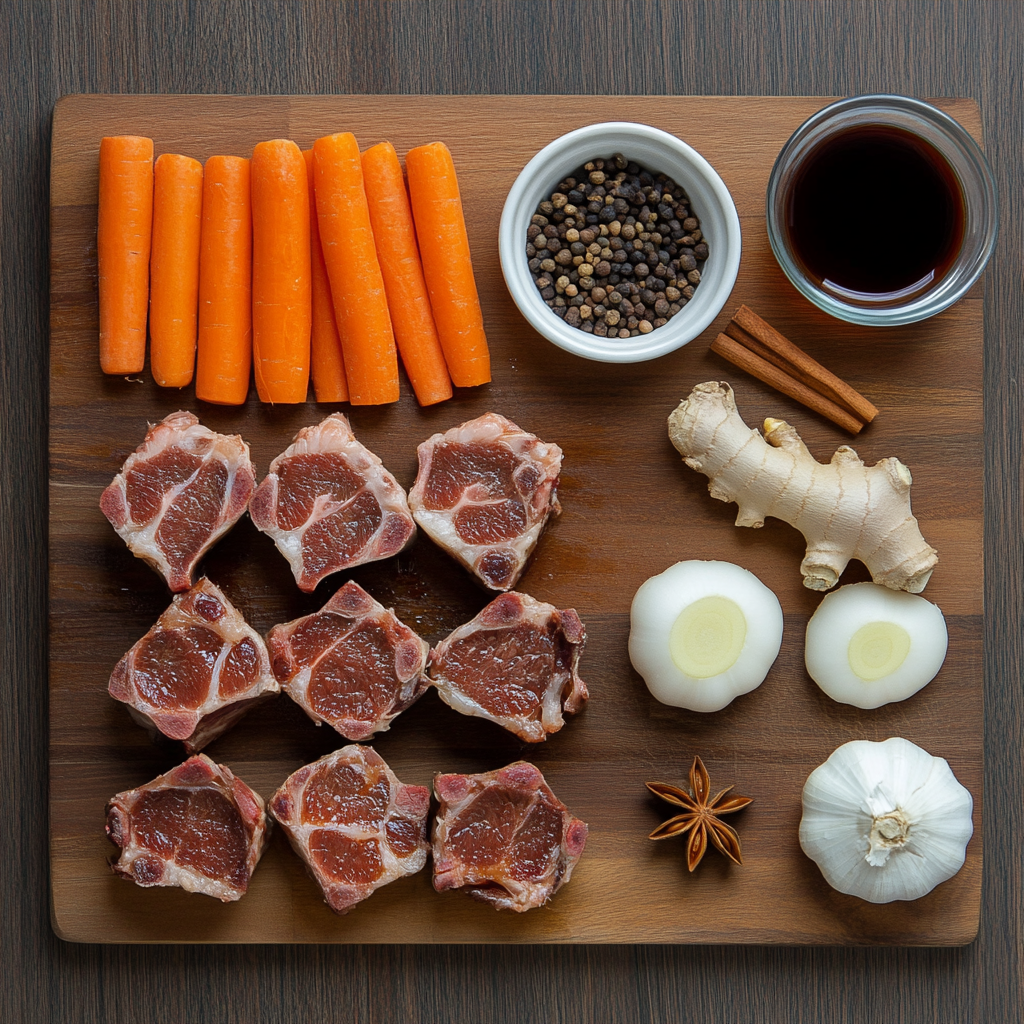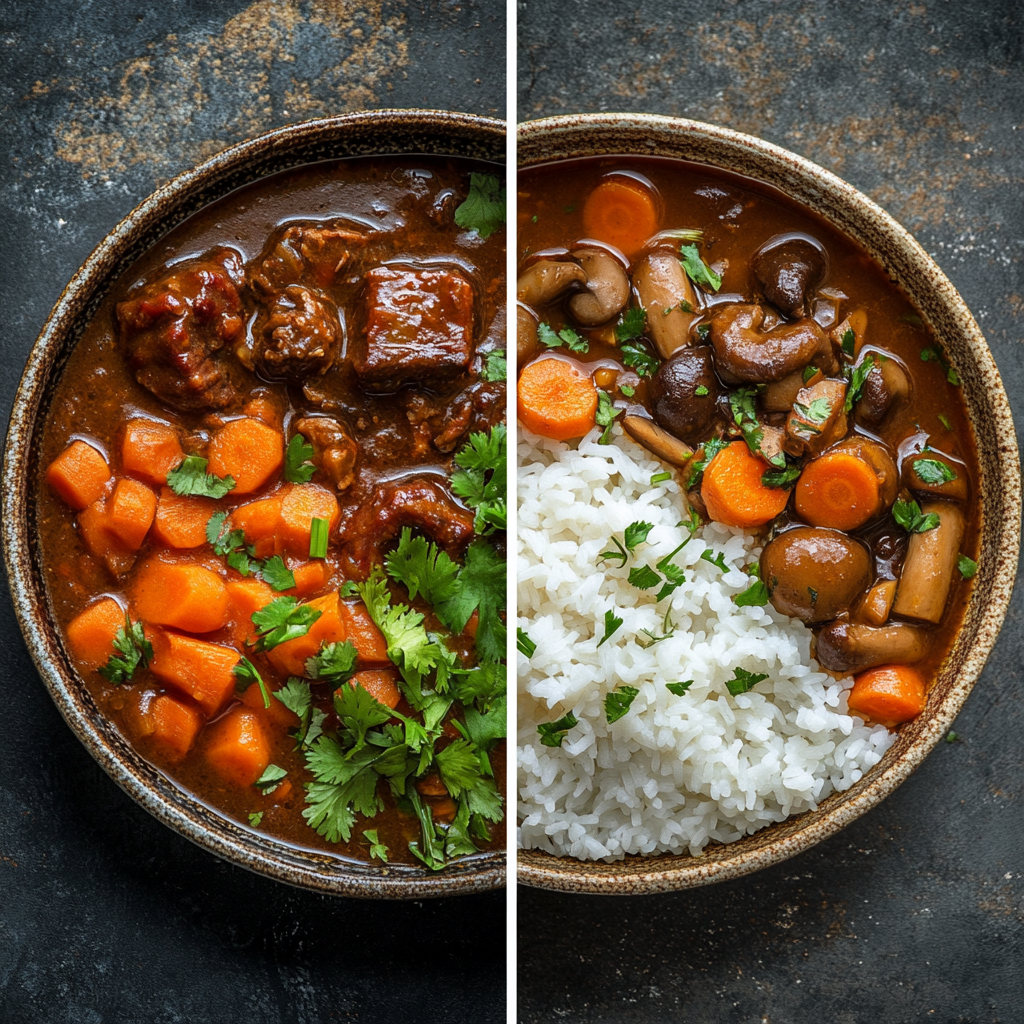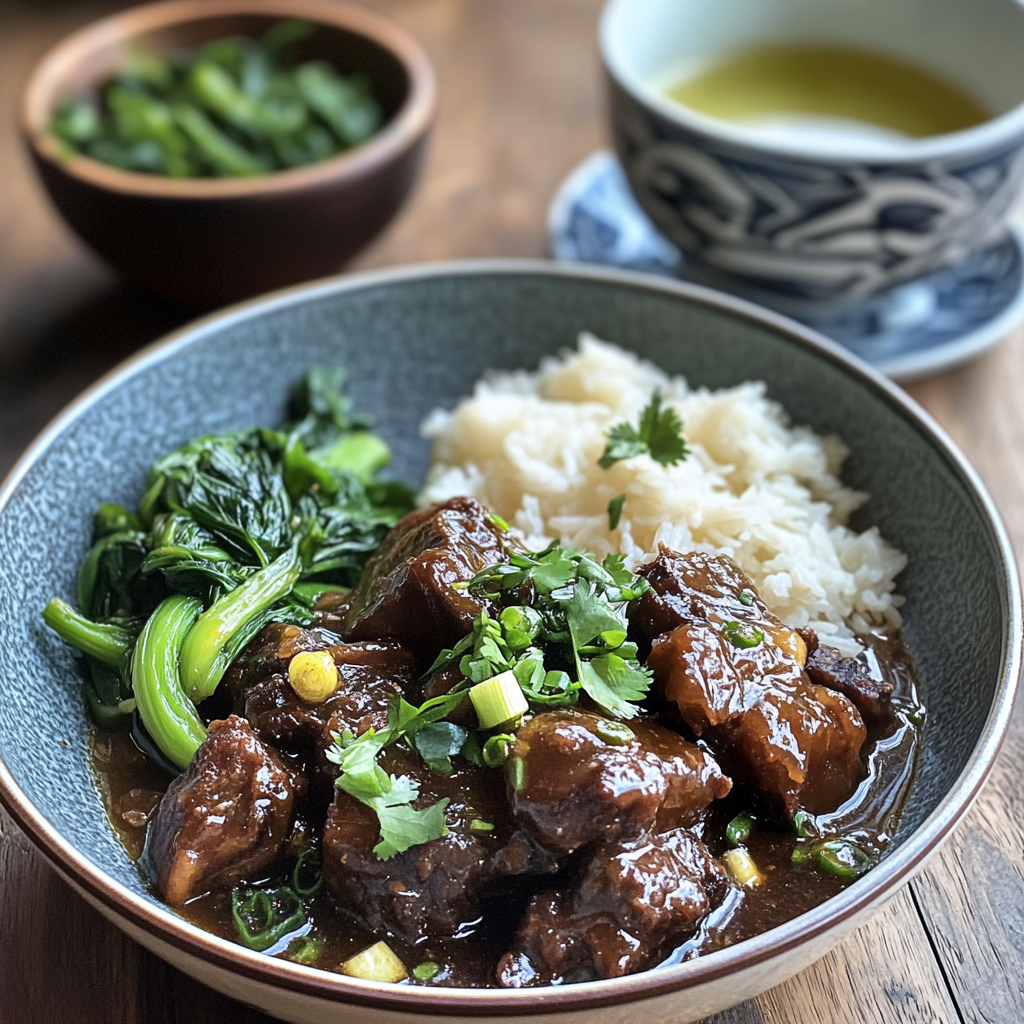Introduction To Asian Oxtail Recipe
When it comes to rich, deeply flavored dishes, Chinese Braised Oxtail tops the list. With its tender meat, slow-cooked to perfection, and the aromatic mix of spices, this dish is a favorite in many Asian households. The beauty of oxtail stew lies in its versatility – you can serve it at a cozy family dinner, or save it for special occasions. This Asian Oxtail Recipe is also perfect for those following a gluten-free diet or anyone looking for a hearty, wholesome meal that fills the kitchen with delightful aromas.
But there’s more! The recipe also features some classic Asian cooking techniques that elevate the dish. The slow simmering, balanced with soy sauce and star anise, brings together all the components that make this dish irresistible. With detailed recipe instructions, even beginners can master this recipe with ease.
If you’re on the lookout for other hearty meal ideas, don’t forget to check out our Dinner section. Whether you’re craving something hearty like oxtail stew or looking for lighter options, we’ve got you covered with recipes that cater to all occasions.
Essential Ingredients for the Best Chinese Braised Oxtail Recipe
The foundation of any great Asian Oxtail Recipe is its ingredients. The key is selecting high-quality, fresh produce and spices that will ensure a flavorful result. For this dish, we’re using ingredients that are not only easy to find but can also be substituted for dietary preferences. Let’s dive deeper into each component of this oxtail recipe and explore possible substitutions.
- Oxtail: This is the star ingredient and what makes this dish unique. The oxtail has a high collagen content, which melts during the long, slow cooking process, resulting in tender, fall-off-the-bone meat. If you can’t find oxtail or prefer a lighter meat, beef shanks are an excellent alternative. However, nothing quite matches the deep, rich flavor of traditional oxtail.
- Soy Sauce: Soy sauce adds umami and saltiness to the dish, balancing the sweetness of the vegetables and spices. If you’re gluten-intolerant, tamari or gluten-free soy sauce can be used as a substitute without compromising the flavor. Soy sauce is integral to any Chinese braised oxtail recipe, lending depth and color to the broth.
- Garlic and Ginger: These two aromatics are common in many Asian dishes. Garlic adds a sharp, pungent flavor, while ginger introduces warmth and freshness. Together, they create the foundation of the dish’s aromatic profile. For those with sensitivities, you can use garlic-infused oil or ginger powder as alternatives, although fresh is always best.
- Star Anise and Cinnamon Stick: These spices bring that characteristic warmth and complexity that make this dish distinctly Asian. The star anise adds a mild licorice flavor, while the cinnamon stick offers a hint of sweetness and spice. You can’t skip these ingredients if you’re aiming for that authentic Chinese braised oxtail flavor.
- Carrots and Daikon: These vegetables absorb the rich broth and help balance the dish’s richness. If you can’t find daikon, radishes make a great substitute, offering a similar texture and flavor. The carrots provide a slight sweetness that complements the other ingredients.
- Beef Broth: The broth serves as the base for this dish, soaking up all the spices and herbs. While beef broth is the traditional choice, you can swap it for vegetable broth for a lighter version. The oxtail recipe will still taste delicious, albeit with a slightly different depth.
If you want more snack or appetizer ideas that pair well with this hearty oxtail stew, head over to our Snacks section for more inspiration!

Essential Tools for Cooking the Perfect Asian Oxtail Recipe
Making an authentic Chinese Braised Oxtail requires some specific kitchen tools, but don’t worry – many of these can easily be substituted with items you probably already have in your kitchen. Here’s a list of the essential tools, along with suggestions for alternatives.
1. Heavy-Duty Pot or Dutch Oven
The heavy-duty pot or Dutch oven is crucial for slow-cooking the oxtail stew. The thick walls and tight-fitting lid allow for even heat distribution and moisture retention, which is key for tenderizing the oxtail. If you don’t have a Dutch oven, a large, deep skillet with a lid can work just as well. The idea is to create an environment where the meat can braise for hours without losing too much liquid.
2. Sharp Chef’s Knife
You’ll need a sharp chef’s knife for prepping vegetables and trimming any excess fat from the oxtail pieces. A dull knife can make this process frustrating and imprecise. If you don’t have a chef’s knife, any sturdy kitchen knife that can handle meat and vegetables will do, but investing in a good knife will make cooking more enjoyable and efficient.
3. Tongs
Tongs are essential for flipping the oxtail pieces during the searing process. They allow you to grip the meat without puncturing it, which keeps the juices inside and helps ensure even browning. If you don’t have tongs, a large fork or spatula can be used, though they might not be as effective.
4. Fine Mesh Strainer
If you want a clearer broth for your Asian oxtail recipe, a fine mesh strainer will come in handy. After slow cooking, the broth can have bits of vegetables and spices floating around, and a strainer helps separate those solids from the liquid. If you don’t have a fine mesh strainer, a slotted spoon can also help remove larger pieces.
5. Wooden Spoon
A wooden spoon is perfect for stirring the broth and scraping up the browned bits from the bottom of the pot during the deglazing process. It’s gentle on the pot’s surface and does a great job of mixing everything without splashing. If you don’t have a wooden spoon, any heat-resistant spoon will work, but wooden spoons are ideal for heat retention and stirring heavier dishes.
For more recipes that utilize similar tools, visit our Dinner section. From slow-cooked meats to hearty stews, you’ll find everything you need to create the perfect dinner at home.
Step-by-Step Recipe Instructions for the Perfect Asian Oxtail Stew
Making the perfect Asian Oxtail Stew is all about following each step with care. From searing the meat to slow-simmering it in a fragrant broth, each step enhances the flavors and textures, ensuring a dish that is both rich and comforting. Here’s a detailed breakdown of the recipe instructions, making it simple for even beginners to follow along.
Step 1: Searing the Oxtail
Begin by heating a tablespoon of oil in a heavy-duty pot or Dutch oven over medium-high heat. It’s essential to get the oil hot before adding the oxtail to ensure a proper sear. Pat the oxtail pieces dry with paper towels, then season generously with salt and pepper. Place the oxtail in the pot, ensuring there’s enough space between each piece. You’ll want to brown each side of the oxtail thoroughly – this process locks in the juices and builds the flavor base for your oxtail stew. Sear the oxtail for 4-5 minutes per side, then remove the pieces and set them aside.
Step 2: Aromatics and Spices
After removing the oxtail, reduce the heat slightly and add the garlic, ginger, star anise, and cinnamon stick to the pot. These aromatics are the heart of the dish, imparting layers of flavor to the broth. Stir for 1-2 minutes, allowing the spices to bloom and release their essential oils. You’ll notice the kitchen filling up with the warm, sweet scent of star anise and cinnamon, mingling with the sharpness of ginger and garlic. It’s crucial not to burn the garlic, so keep a close eye on the pot.
Step 3: Deglazing the Pot
Once the aromatics are fragrant, it’s time to deglaze the pot. Add soy sauce and a splash of water to the hot pot, stirring to scrape up any browned bits stuck to the bottom. These bits are packed with flavor and will dissolve into the broth, enriching the entire dish. Bring the mixture to a boil to help incorporate all those flavors.
Step 4: Simmering the Oxtail
Now it’s time to return the oxtail to the pot. Pour in the beef broth, ensuring the oxtail is mostly submerged. This is where the magic happens – the long, slow cooking process tenderizes the meat and allows the flavors to meld. Bring the broth to a boil, then reduce the heat to low, cover the pot, and let it simmer gently for 2-3 hours. The low and slow cooking process is essential for breaking down the tough connective tissues in the oxtail, making the meat incredibly tender and flavorful.
Step 5: Adding the Vegetables
When the meat is nearly tender, it’s time to add the carrots and daikon. These vegetables will soak up the flavorful broth and add a touch of sweetness to balance the savory and spiced elements of the stew. Let the vegetables simmer for the last 30 minutes of cooking, ensuring they become tender without turning mushy.
Step 6: Finishing Touches
Once the oxtail is fall-off-the-bone tender, remove the star anise and cinnamon stick from the pot. Taste the broth and adjust the seasoning with more soy sauce or salt if needed. You can also skim off any excess fat that has risen to the surface for a cleaner-tasting broth.
For more recipes that employ similar techniques, check out our Dinner section, where you’ll find hearty dishes that are just as comforting and rich as this oxtail stew.
Flavor Variations and Substitutions for Asian Oxtail Stew
While the traditional Chinese Braised Oxtail recipe is perfect as it is, there are numerous ways to customize it to your liking. Whether you want to adjust the spice level, make it vegan, or go low-carb, here are several variations to try:
1. Spicy Oxtail Stew
If you enjoy a bit of heat, consider adding dried chilies or a spoonful of chili paste to the broth during the simmering process. This will give the oxtail stew a warming, spicy kick without overpowering the other flavors. You can also garnish the dish with freshly sliced red chilies for an extra burst of heat.
2. Vegan Oxtail Stew
For those following a plant-based diet, you can easily turn this dish into a vegan oxtail stew by substituting the oxtail with meaty mushrooms, such as shiitake or portobello. The mushrooms will absorb the broth’s rich flavors, providing a similar texture and depth of taste. Replace the beef broth with a rich vegetable broth, and keep all the same spices and vegetables for an equally satisfying meal.
3. Low-Carb Option
For a low-carb version of this oxtail recipe, swap the traditional rice or noodles for cauliflower rice or zucchini noodles. These alternatives will soak up the delicious broth without adding extra carbohydrates, making this a great option for those on a keto or low-carb diet. The richness of the oxtail and the flavors of the broth are enough to make this dish satisfying even without the carbs.
For more light snacks or side dishes that can accompany these variations, visit our Snacks section. There, you’ll find a wide range of options to complement the flavors of your Asian oxtail stew.

Expert Tips for Mastering the Chinese Braised Oxtail Recipe
Cooking Chinese Braised Oxtail to perfection requires attention to detail and a few insider tricks. Here are some expert tips that will help you make the most of this delicious oxtail recipe every time:
1. Skim the Fat
Oxtail is naturally fatty, which contributes to its rich flavor. However, for a cleaner broth, you’ll want to skim the fat that rises to the surface during cooking. You can use a spoon to remove the fat while the stew simmers, or refrigerate the dish after cooking and skim off the solidified fat before reheating.
2. Don’t Rush the Browning Process
One of the keys to a flavorful Asian oxtail stew is properly browning the oxtail at the beginning. Take your time with this step – you want each piece to be deeply caramelized on all sides. The browned bits left in the pot will enrich the broth, making it more flavorful.
3. Cook Low and Slow
Patience is essential when making oxtail stew. The longer the oxtail simmers, the more tender and flavorful it will become. Resist the urge to rush the process – the slow cooking time allows the collagen in the oxtail to break down, creating a luxurious, silky texture in the broth.
If you’re interested in other recipes that utilize similar cooking techniques, check out our Dinner section. We’ve got plenty of hearty, slow-cooked dishes that are perfect for any occasion.
Nutritional Information: Health Benefits of Asian Oxtail Stew
While indulgent and hearty, Asian oxtail stew also offers a range of nutritional benefits. Oxtail is an excellent source of protein, which is essential for muscle repair and growth. It also contains a high amount of collagen, which supports joint health and is great for skin elasticity. The broth, enriched with vegetables like carrots and daikon, adds a good dose of vitamin A, fiber, and other essential nutrients.
Star anise and cinnamon, key spices in this Chinese braised oxtail recipe, also have health benefits. Star anise is known for its anti-inflammatory properties, while cinnamon can help regulate blood sugar levels.
For a deeper look into the nutritional value of this dish, visit this trusted source for more information on how the ingredients contribute to a balanced diet.
Serving Suggestions for Asian Oxtail Recipe
The richness of this Asian oxtail recipe pairs beautifully with simple sides and refreshing drinks. Here are a few serving suggestions that will complement the dish perfectly:
1. Steamed Jasmine Rice
The traditional pairing for Chinese braised oxtail is steamed jasmine rice. The soft, fragrant rice soaks up the rich broth, making each bite an explosion of flavor.
2. Garlic Bok Choy
A lighter side dish like sautéed garlic bok choy offers a crisp contrast to the tender oxtail. The slight bitterness of the bok choy helps balance out the richness of the stew.
3. Green Tea
For a refreshing, non-alcoholic drink that pairs well with the deep flavors of this dish, green tea is an excellent choice. Its light, herbal notes provide a perfect contrast to the richness of the oxtail.
For more dinner ideas and side dishes that complement this oxtail recipe, visit our Dinner section, where you’ll find plenty of options for building a complete meal.

How to Store and Reheat Asian Oxtail Stew for Best Results
If you’re lucky enough to have leftovers, this Asian oxtail recipe stores incredibly well. In fact, the flavors tend to deepen and develop over time, making the dish even more delicious when reheated.
1. Refrigeration
Store leftover oxtail stew in an airtight container in the refrigerator for up to 3 days. To reheat, simply place the stew in a pot over low heat until warmed through. Be sure to stir occasionally to ensure even heating.
2. Freezing
This dish also freezes exceptionally well, making it a great make-ahead meal. Let the stew cool completely before transferring it to freezer-safe containers. You can freeze it for up to 3 months. When you’re ready to eat it, thaw the stew in the refrigerator overnight before reheating on the stovetop.
Frequently Asked Questions (FAQs) About the Asian Oxtail Recipe
Can I make this dish ahead of time?
Yes! In fact, making this Chinese braised oxtail ahead of time allows the flavors to meld and develop. It’s an excellent make-ahead dish that tastes even better the next day. Simply store it in the refrigerator and reheat on the stove before serving.
What can I use if I can’t find oxtail?
If you can’t find oxtail, beef short ribs or shank are good substitutes. They offer similar richness and tenderness after slow cooking, although they won’t have the exact same flavor and texture as oxtail.
For more helpful tips and answers to common recipe questions, visit our Dinner section, where we dive into cooking techniques and ingredient substitutions.
Conclusion: Why You Should Try This Chinese Braised Oxtail Recipe Today
Whether you’re new to braising meats or a seasoned cook, this Chinese Braised Oxtail Recipe is a must-try. The combination of slow-cooked, tender oxtail, aromatic spices, and flavorful broth makes it a perfect dish for family dinners or special occasions. Plus, the versatility of this recipe allows you to tailor it to your dietary needs, whether you’re gluten-free, low-carb, or vegan.
So why wait? Get your ingredients ready and give this Asian oxtail recipe a try! You’ll be amazed by how easy it is to create such a rich, flavorful dish at home.
